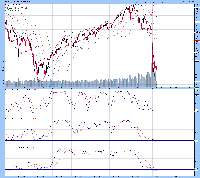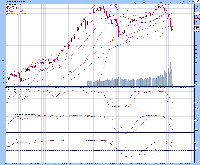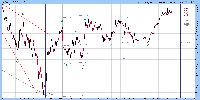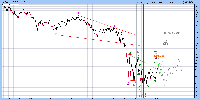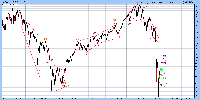|
|||
S&P 500 UpdateDavid Petch Note: This article was posted for the benefit of subscribers on January 7th, 2009 The CBOE Options Equity Put/Call Ratio Index is shown below, with the S&P 500 shown in the background (black line) and accompanying full stochastics below. For this particular chart, the %K beneath the %D is a general sign of broad market strength while the %K above the %D indicates broad market weakness. The %K is beneath the %D, indicating broad market strength, but with today's 12 point decline first off in the AM it is likely the %K could be in the process of reversing higher. The S&P could meander lower over the course of the next 3-4 weeks before a setup for a sharp decline likely occurs before mid-February 2009. Figure 1 The daily chart of the S&P 500 Index is shown below, with accompanying stochastics 1, 2 and 3 shown below in order of descent. The %K is above the %D in #2 and #3 and "appears" to be trying to curl up to cross the %D in #1. Another 2-3 weeks of a grinding declining top prior to a precipitous decline is the most likely event to occur. Upper 21 and 34 MA Bollinger bands are in close proximity, with the lower 21 MA BB requiring another 1-2 weeks in order to rise high enough to "kiss" the index, thereby creating a setup for the next leg down in the pattern. I must stress that it was important for the S&P 500 Index to put in a low around 780-800 anytime from mid to late December 2008 in order to create a scenario for an extended rally. Failure for this to occur in the presence of a grinding market is increasing the odds that any sort of stock market rally into spring time is quickly fading. I put in a possible Elliott Wave count that I have not presented yet... a diametric triangle "could" be forming, which would have wave (E) starting a decline pattern that would require lasting until mid-March 2009 before a corrective bounce lasting into early May, followed by a final low established in June/July 2009. Diametric patterns require similarity in time and complexity, not price action, so in order for this scenario to pan out, the S&P 500 Index "must" continue to decline over the course of the next 2 months. Figure 2 The weekly chart of the S&P 500 Index is shown below, with lower Bollinger bands still declining beneath the index. Upper Bollinger bands are curling down, indicating that any sort of market stability is at least 8-12 months out. Full stochastics 1, 2 and 3 are shown below in order of descent, with the %K above the %D in #1, but beneath it in the other two. The S&P is oversold, but stock market crashes occur when markets are oversold. Avoid going long on the S&P at present, given stock market uncertainty. Establishing short positions with gradual accumulation is probably the best way to play this. Figure 3 The monthly chart of the S&P 500 Index is shown below, with lower Bollinger band in close proximity to the index closing price, thereby suggestive that the decline still is underway. Notice that the S&P 500 Index has fallen beneath the 155 and 200 month moving averages, something that has not even remotely occurred in the 20 years of data shown below. Full stochastics 1, 2 and 3 are shown below in order of descent, with the %K beneath the %D in all instances. Notice that the %K in stochastic 3 still has significant downside before a bottom is put in place, likely late 2009/early 2010. This chart clearly indicates that broad stock indices could be in trouble. It is highly unlikely that a further 40-50% decline in the S&P 500 Index from present level would not see precious metal and energy stocks go untouched. Precious metal stocks have doubled off the lows and have yet to correct, which likely will occur when the broad stock market declines. Ownership of gold and silver bullion is the best investment in the present environment... if it can be obtained. Figure 4 The short-term Elliott Wave count of the S&P 500 Index is shown below, with the preferred count shown in colour and the alternate count shown in grey. The best way to label the move off the lows of November is to label it as a triangle. There other ways of labeling the pattern, such as a double combination (zigzag-x wave-flat), so multiple interpretations are possible. Figure 5 The mid-term Elliott Wave count of the S&P 500 Index is show below, with the preferred count shown in colour and the alternate count shown in grey. The preferred count suggests an immediate decline, while the alternate count has a few possibilities such as a double combination extending the present consolidation out into March/April 2009. It is important to note that a decline to around 800-810 is a prerequisite in order to have another move higher. Failure for the S&P to have any upside momentum the past few days removes any short-term upside and in turn has set up the likely scenario for 1-2 weeks of downside at a minimum before the 800 level is reached. Figure 6 The long-term Elliott Wave count of the S&P 500 Index is shown below, with the preferred count shown in colour and the alternate count path shown in grey. In order to link the possible Elliott Wave count shown in Figure 2 to below, wave b would be required being shifted one peak to the right where wave B is shown. Figure 7 There are numerous possibilities presented today and the market will determine which path it follows. It is important to realize that when the market locks into whichever presented pattern, odds are it will follow the defined path. The patterns either call for an immediate decline to the lower market depths, or a further "pause" before commencing on that journey. In short, the S&P should make a low anywhere from 800-850 over the course of the next 2-4 weeks... from that point in time, it will become easier to assess whether or not a rally can be sustained into March/April 2009 or if the downward spiral of the broad market indices continues. Jan 7, 2009 |



